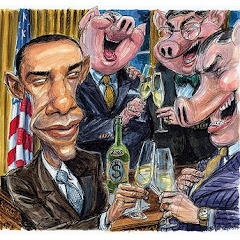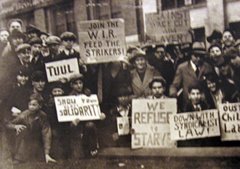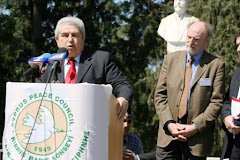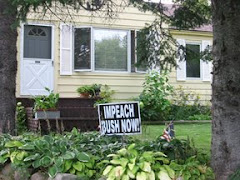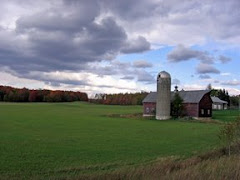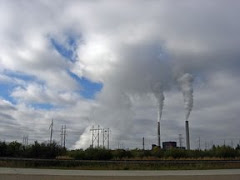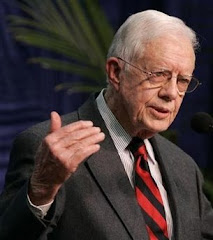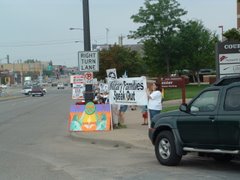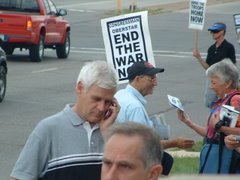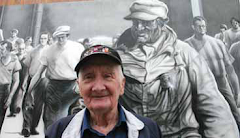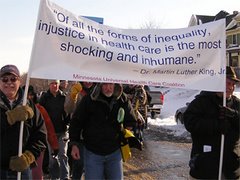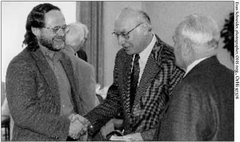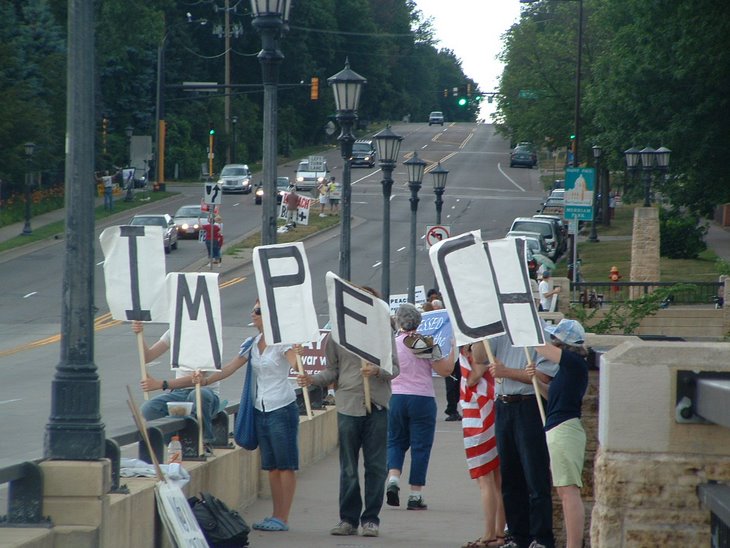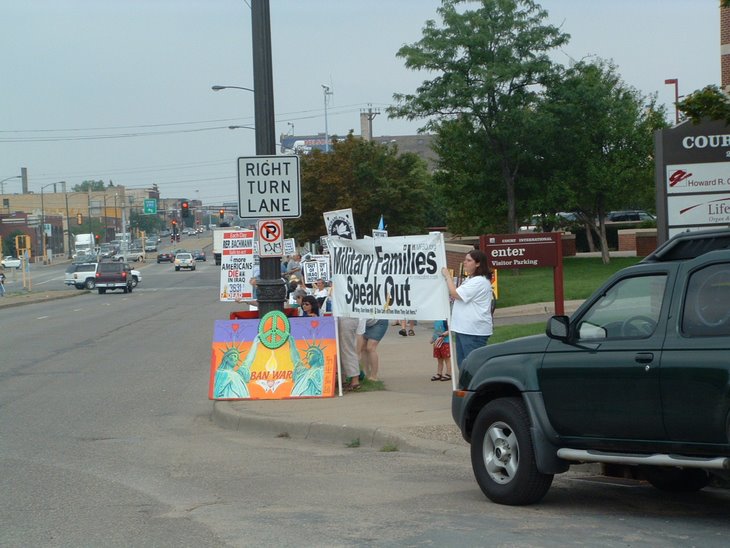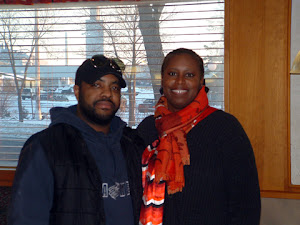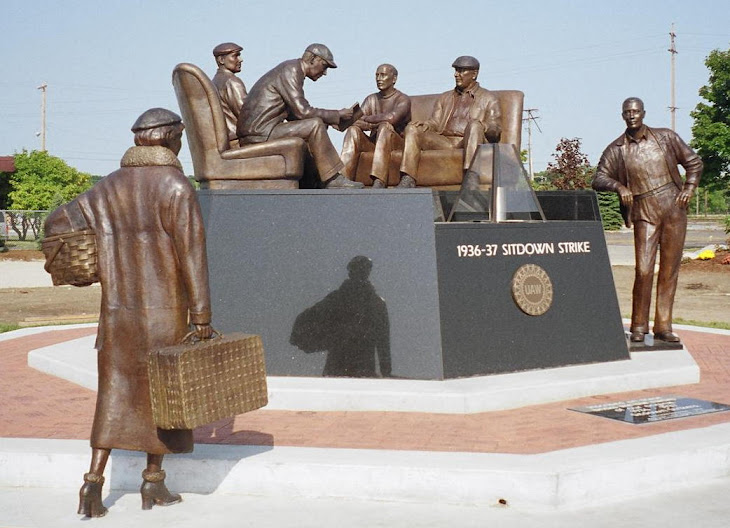Monday, April 16, 2007
The "Summit Hill" Crowd
I will be focusing on this issue on my blog over the next several months.
I think the time is now for hearings to determine if there isn’t some conflict of interest in what is going on with the Ford Plant and the Ford Site Planning Committee. Maybe some newspaper will have the courage to assign a few reporters to investigate what the Ford Motor Company is exchanging two thousand or more good paying jobs with excellent benefits for.
I think we need to know if the Ford Motor Company hasn’t made the decision to demolish this Plant because they have a more profitable scenario in mind. Keep in mind, Ford seems very unusually interested in the future of this property for a company that wants to abandon the property. Isn’t it kind of strange that no one has asked Ford if they intend to maintain a future financial interest as this property is "developed?"
I found many people in St. Paul struggling to keep their heads above water in paying mortgages ranging from $1,300.00 to over $4,000.00 dollars a month… and the Ford Site Planning Committee is planning for upscale housing for the well-heeled. Please see the last article from “The Nation”… in the same way, many homeowners in St. Paul are being foreclosed on right now because there is no way for them to meet their mortgage obligations; and neither the Mayor nor any city council members have stepped forward to assist these people. The DFL legislators have done absolutely nothing to halt predatory, parasitic lending, either.
I think we are getting a very good idea of the type of “planning” the Ford Site Planning Committee has in mind for this site…
Here is what I think “The Summit Hill Crowd” is looking at:
I think we will see a marina and high priced condos and town houses along the river and a new huge casino… luxury hotels and high-priced shops with artists and artisans.
I think we will see Ford remain as a partner in all of this much like what we see that Whirlpool Corporation has done in Benton Harbor, Michigan; as it shut down production in this community and moved production south and overseas. The properties and the economic scenarios are very similar.
We will see several thousand “service jobs” created that pay between $7.00 and $8.50 an hour with virtually no benefits; with tax-payers subsidizing these poverty wages with food stamps and welfare payments; and other workers throughout the area will suffer with this massive downward pressure on wages… we will see poverty in the Twin Cities soar out of sight and homelessness climb as soup kitchens scramble to keep up with their “new business.”
We will see the Minnesota Environmental Advocacy Council, a front for every polluting corporation in Minnesota, support all of this in the name of “open green spaces;” in the form of a few ballparks and a few small parks with some swings along with walking and biking trails.
I think we will see the City of St. Paul turn over its River Front property to these vultures known as venture capitalists and real estate speculators.
We will see the St. Paul Police Department crack down on child panhandlers; and, around election time crack down on prostitution.
Has anyone thought to ask if there might be some kind of conflict of interest among the public officials involved in all of this? Perhaps someone involved from the Mayor’s office or on the Ford Site Planning Committee has connections to gaming and real estate interests who will profit from all of this?
The “Summit Hill” crowd has big, big, plans for the Ford Property.
I can’t help but wonder how many members of the DFL state legislative caucus know what is going down here but won’t say. This may turn out to be one of the worst perversions of the democratic process in Minnesota history… not to mention the state's biggest boon-doggle.
I think we need to know why the UAW’s Gettelfinger has not dared to show his face in the Twin Cities to address this mess.
We may have to consider some kind of independent political action to address all of this. I think the time has come for the mass distribution of a special edition of a newspaper specifically focused on the future of the Ford Plant. Maybe even some kind of ballot initiative on public ownership of this plant.
Again, like the peat mining in the Big Bog, Minntac’s intent to contaminate the streams, rivers, and lakes of northern Minnesota and Lake Superior, and on the issues of single-payer, universal health care and the war in Iraq, the DFL State Central Committee and even the DFL Progressive Caucus refuses to address the issues involved in the Ford Plant closing and demolition. The continued silence is getting old. The Green Party has done no better. This is not being discussed on any of these list serves--- Shove’s Progressive Calendar has had little mention, while Charles Underwood’s “Peace Calendar” has not published anything in spite of a large sign promoting the war in Iraq at the Ford plant gate on Ford Parkway. I think we have a right to ask the question: What gives here?
I think we have to consider the influence that grants from “philanthropic foundations” in Minnesota have had in influencing the organizations that we have come to expect that would stand up and fight for what is right; my opinion is, that silence has been purchased.
Here are some web sites you might want to check out if you think the scenario I am putting forward is far-fetched:
http://www.epa.gov/swerosps/bf/06arc/harborshores.htm
http://www.chicagofed.org/publications/msa/msa12_01.pdf
http://www.abonmarche.com/devcomplete.html
http://www.michigan.gov/deq/0,1607,7-135-3308_3323-163914--,00.html
http://www.cornerstonechamber.com/about/pressroom.taf?do=read&newsid=12 (note the very last item in this press release by the Chamber of Commerce)
Check out how opponents to this kind of development are being treated in Benton Harbor, Michigan:
Published Apr 12, 2007 10:05 PM
The Rev. Edward Pinkney won’t be alone in Benton Harbor, Mich., when he faces the racist power structure that is trying to silence him and his organization, BANCO (Black Autonomy Network of Community Organizations). On March 21, the Rev. Edward Pinkney was convicted by an all-white jury on charges that supporters explain were highly motivated by political struggles taking place in Berrien County, Mich.
Detroit supporters are already organizing bus transportation to fill the courtroom when he is sentenced on May 14.
Rev. Pinkney was accused of five counts of election improprieties during the successful 2005 recall election of Glen Yarbrough, Benton Harbor city commissioner and supporter of the Harbor Shores Development.
In the first trial, a jury with two African-American participants could not reach agreement. Charges included merely having another person’s absentee ballot in his possession. Pinkney admitted giving stamps and labels to people who could not afford to buy stamps to send in their absentee ballots.
A well-known community leader, Rev. Pinkney relentlessly exposes the racist court and economic system oppressing the mostly African-American people of Benton Harbor. The details of his trial and the jury selection prove once again what he has said all along about the unjust and racist treatment of the Benton Harbor people, especially the exclusion of Black jurors.
Wayne Bentley, a Kent County jury commissioner from Grand Rapids, reviewed three years of jury questionnaires from Berrien County where Rev. Pinkney’s trial took place. He found five ways that poor people—who in this racist society are disproportionately people of color—are currently being systematically under-represented on juries in that county.
But what about that Harbor Shores Development?
Harbor Shores is planned to be an upscale housing, retail development, a Jack Nicklaus golf course and more, on land currently owned by the initiator of the $500 million project—the transnational Whirlpool Corporation—and public land on the Lake Michigan shoreline owned by the city of Benton Harbor.
While the project, undoubtedly a big tax write off for Whirlpool, is portrayed as an “anti-poverty program” for the people of Benton Harbor, the city would only receive $1 million for the land and the people of Benton Harbor would receive “training” while being used as the excuse to get tax moneys from the state of Michigan to clean up former industrial sites for the developers.
In much the same way that U.S. “foreign aid” never really helps people in oppressed countries, capitalist “developments” don’t do much for poor communities here, especially Black and Latino communities.
Rev. Pinkney told the truth and tried to stop the capitalist bonanza called Harbor Shores. Could his truth about this racist enterprise have been his “crime”?
******
Could such treatment be in the future of those opposing the plans of the Ford Site Planning Committee… on Election Day the St. Paul Police Department blocked off a section of Ford Parkway up the hill from the Ford Plant with hundreds of people looking on as a dangerous “terrorist suspect” was detained for the “crime” of taking photos without consulting the proper authorities or obtaining permission. The dangerous “terrorist suspect” that the St. Paul Police Department detained for over an hour while blocking the street was me.
Watch my blog for photos:
http://thepodunkblog.blogspot.com/
Any concerned person has to ask: What the hell is going on in this country?
Really, do two thousand working people have to give up their jobs so Ford can stuff its corporate coffers even more?
Minnesota legislators were very eager to offer the Ford Motor Company all kinds of handouts in order to keep the production in the Twin Cities, however, have politicians and Ford Motor Company reached an even more lucrative deal for Ford that we haven’t been told about? I think this question needs to be asked.
*****
The New Suburban Poverty
By Eyal Press
The Nation
23 April 2007 Issue
Rockingham County, North Carolina, has never been known for its opulence, but until recently most residents would not have hesitated to describe it as comfortably middle class. For several decades the county, a rectangular block of land in the north central part of the state, owed its prosperity to textile mills and tobacco plants, industries that weren't always friendly to unions but that nevertheless furnished the local workforce with jobs that paid enough to raise a family and buy a nice house somewhere.
Among those to do so was Johnny Price, a 44-year-old African-American who lives in a ranch house with green shutters on a street called Sparrow in a leafy residential subdivision on the outskirts of the town of Eden. Two towering oak trees dominate Price's front lawn. In his driveway sits a navy blue station wagon. By the standards of some newly built suburbs, the setup is modest, but for Price, the youngest of ten children whose father died when he was 6 and whose mother worked as a domestic servant, it's a testament to the rewards of hard work and perseverance, values he's tried to instill in his teenage son and daughter, who have lived with him since he and his wife divorced. Lately this has gotten more challenging. A year ago Price lost the job he'd held for nineteen years in company-wide layoffs at Unified, a textile manufacturer. He's now struggling to make do on $1,168 in monthly unemployment benefits and, like many people in Rockingham County, which has been ravaged by plant closings in recent years, wondering how long he'll be able to continue paying his mortgage.
Stories of downward mobility in America's suburbs have not exactly cluttered the headlines over the past decade. Gated communities of dream homes, mansions ringed by man-made lakes and glass-cube office parks: These are the images typically evoked by the posh, supersized subdivisions built during the 1990s technology boom. Low-wage jobs, houses under foreclosure, families unable to afford food and medical care are not. But venture beyond the city limits of any major metropolitan area today, and you will encounter these things, in forms less concentrated - and therefore less visible - than in the more blighted pockets of our cities perhaps, but with growing frequency all the same. In the three counties surrounding Greensboro, North Carolina, the city half an hour south of where Johnny Price lives, the poverty rate has surged in recent years. It now stands at 14.4 percent, only slightly below the level in New Orleans.
Greensboro, it turns out, is not alone. Last December the Brookings Institution published a report showing that from Las Vegas to Boise to Houston, suburban poverty has been growing over the past seven years, in some places slowly, in others by as much as 33 percent. "The enduring social and fiscal challenges for cities that stem from high poverty are increasingly shared by their suburbs," the report concludes. It's a problem some may assume is confined to the ragged fringes of so-called "inner ring" suburbs that directly border cities, places where the housing stock is older and from which many wealthier residents long ago departed. But this isn't the case. "Overall ... first suburbs did not bear the brunt of increasing suburban poverty in the early 2000s," notes the Brookings report, which found that economic distress has spread to "second-tier suburbs and 'exurbs'" as well.
The result is a historic milestone that has gone strangely ignored: For the first time ever, more poor Americans live in the suburbs than in all our cities combined.
One reason this shift may not have sunk into public consciousness is that for as long as suburbs have existed, Americans have tended to envision them as pristine sanctuaries where people go to escape brushing shoulders with the poor. The most familiar historical example - much lamented by a generation of progressives who came to associate the migration to suburbs with racial backlash and urban decline - is the mass exodus of middle-class white ethnics from the nation's central cities, which accelerated in the wake of the riots and social unrest of the 1960s. In more recent years, it's often assumed, the forces fueling the growth of suburbs have only made things worse - the social landscape more segregated, the sprawl more extreme, the gap increasingly vast between people who rarely set foot in cities and those who rarely leave them.
In fact, however, the gentrification of many urban neighborhoods, from Brooklyn to San Francisco to Washington, has forced many working-class residents out. In a reversal of the classic migration story, many of these displaced residents have fled to the suburbs, lured in part by the growing pool of mostly low-wage jobs there - cleaning homes, mowing lawns, staffing restaurants, strip malls and office plazas. Alan Berube, co-author of the Brookings Institution study, says the "decentralization of low-wage employment" is one of the main factors driving suburban poverty rates up.
In some counties, a lot of those jobs are falling to immigrants, who are increasingly heading straight to the suburbs rather than to cities in search of employment. In his 2004 book On Paradise Drive, David Brooks presents a sunny portrait of the gorgeous mosaic that the influx of foreigners into formerly lily-white subdivisions has wrought. "Now you'll see little Taiwanese girls in the figure-skating clinics, Ukrainian boys learning to pitch," he writes.
What you'll also see are people like the day laborers who gather every morning in the parking lots of the Home Depots in Nassau County, Long Island, where the median family income is $87,558 and the overall poverty rate is fairly low, but where the demand for food stamps has increased by 40 percent since 2003. Although the median hourly wage for the roofing and construction jobs that day laborers land is $10 an hour, many don't see a penny of this: A study last year by researchers at UCLA found that nearly half experience wage theft. A worker from Mexico I spoke with on a frigid day in February said he was owed $400 for some plumbing he'd done recently. Like most of the other men around him, he wore a hooded sweatshirt rather than a coat and cupped his fingers around his mouth to warm his bare hands, proper winter apparel evidently being an unaffordable luxury. Because the work is seasonal and sporadic, few day laborers earn more than $15,000 a year. More than half of those injured on the job don't receive the medical care they need.
Other immigrants on Long Island ply trades whose wages and hours call to mind certain features of urban sweatshops, save that the exploitation, like so much else in suburbia, is more hidden and dispersed. "We did a survey of domestic workers here and found that people were working seventy-hour weeks and getting, on average, $4.03 an hour," said Nadia Marin-Molina, director of an immigrants' rights organization called the Workplace Project, in Nassau County. Not long ago, three workers dropped by her office from a nearby restaurant to report they'd been getting $20 for twelve-hour shifts, well below the minimum wage even after factoring in tips. At a deli in the town center of Garden City, an affluent enclave of sprawling homes and fancy shops just down the road from the Workplace Project's modest headquarters, several others were fired simply for demanding to be paid on the books. Last year, the Workplace Project helped immigrants in Nassau County recuperate $143,849 in back wages, some from contractors who paid them with checks that bounced, others from companies like Popeyes and D'Angelo Pizzeria that didn't compensate them for overtime.
That landing a service job hardly guarantees earning an adequate income would not come as news to former factory workers in North Carolina. Johnny Price is currently enrolled in courses at Rockingham Community College, funded under the Trade Adjustment Act, in the hope of becoming an accountant. He told me there's no way he could keep up with his $700 mortgage payments and support his kids working as a clerk in a place like Wal-Mart, a major employer with two new stores in the area.
Price used to make $15 an hour, with health benefits and vacation days. What he's hoping to avoid is the fate of people like Jodi Wilmouth, whom I met at the Rockingham County Red Cross, which opened a food pantry several years ago in a low-slung brick building in Eden. Wilmouth earns $6.25 an hour as a cashier at a local department store called Belk, which she said is not enough to cover her basic expenses. On the day she dropped by, President Bush was visiting a Caterpillar plant in Peoria, Illinois. He later said that in today's economy "workers are making more money."
Ada Wells, who works at the food pantry, offered a different view. "What we have are the working poor," said Wells, another former textile employee. "When I left my factory in 1999, the lowest-paid workers made $9 an hour, with insurance and vacation days. Now we have people who can't pay their electricity bills on the wages they earn."
There are certain comparative advantages to being poor in a place other than inner-city Cleveland or Detroit. Whatever else he may fear, Price doesn't have to worry about his children growing up on a street strewn with crack vials and gang graffiti - the one he lives on has manicured lawns and driveways with basketball hoops. The peculiar toxicity of urban poverty, many scholars believe, rests in its intense concentration, the welter of enmeshed problems that fuel crime, spiraling dropout rates and an air of hopelessness that leeches into every aspect of neighborhood life.
But the suburbs also have their disadvantages, among them the fact that getting anywhere generally requires a car. There's no public transportation system in most outlying suburban areas, which is why the people who show up at the food pantry at the Red Cross in Rockingham County often carpool to get there, cramming one person each from four or five families into a single vehicle to save gas. Then, too, the newness of suburban poverty means in many towns there's a dearth of social service agencies to offer help. Nearly 7,000 people showed up at the food pantry last year, a sevenfold increase from 2000. "It's overwhelming," said Janna Nowell, the facility's director. The day before I visited, the pantry ran out of food, a problem that's become familiar in many suburban locales. "There's a growing spatial gap between the providers and the people in need," says Alan Berube. "Public hospitals, nutrition assistance programs - most of these things are still overwhelmingly urban. You see small-scale operations in suburbs getting inundated. They just can't deal with the demand."
An even more vexing challenge is finding an affordable place to live, since most of the low-income, subsidized housing in America was built in cities. Where do indigent people in the suburbs go? In North Carolina, among the few options are places like the slate-gray trailer that 62-year-old Barbara Hall now calls home. She used to live in a four-bedroom ranch house with her husband and kids. That was before she got divorced and lost her job. "It's humiliating," says Hall, who has long silver hair, clear blue eyes and a chronic bad back that requires her to take medication she can't currently afford.
There are, of course, more fortunate people in the suburbs whose houses have doubled and tripled in size in recent years - tech workers in the booming area surrounding North Carolina's research triangle, for example. But since 1998, housing foreclosures in North Carolina have nearly tripled.
The trend extends beyond the South - there were 1.2 million foreclosures across the country in 2006, a 42 percent increase from the previous year - and is among the indications that the number of people under economic duress in many suburbs far exceeds the percentage that is officially poor.
Compared with Barbara Hall, who is unemployed and surviving on disability checks, Rosa Melara, who lives in Montgomery County, Maryland, a suburban area adjacent to Washington, is doing well. Melara works in a nail salon and earned $28,000 last year. She also lives in a county with more low-income housing than most suburbs, thanks to inclusionary zoning policies that for decades have required affordable units to be built in large-scale developments. Yet Melara rents a converted garage without heating because most of the apartments and houses in Montgomery County are still well beyond her means. About half the parishioners in the church she attends in suburban Bethesda are facing similar problems, she told me.
I met Melara at another church in neighboring Howard County, also in the Washington-Baltimore corridor and for several years among the wealthiest counties in the United States. Last year a task force on affordable housing appointed by County Executive James Robey warned that "an undeniable gap" exists between the need for low-income housing and its availability in the area, and not only for the poor. Seventy percent of the jobs in the county, including those of entry-level teachers in its celebrated public school system, cops who patrol the streets and firemen who respond to emergencies, pay less than $50,000 a year. Meanwhile, the average single-family house sold for nearly ten times that amount, $485,500, and rents have crept ever higher. The result is that a growing share of the population - public servants, couples starting families, retirees, recent college graduates - can't find affordable places to live, according to the task force: "These are the children and parents of County residents," its report stated, "County teachers and police officers, the waiters and waitresses who serve meals, the Mall workers, the hospital workers, the people who contribute to the quality of life in Howard County in countless ways."
The dilemma is far worse, of course, for the truly indigent, not least because a lot of suburbanites who might be willing to hire them as nannies or to be served by them at restaurants don't necessarily want them as neighbors. In June 2005 authorities in the town of Brookhaven, in Suffolk County, Long Island, launched a series of raids to shut down overcrowded homes in which immigrants lacking other affordable options were renting rooms. County Executive Steve Levy, a Democrat, declared that the evictions were necessary to "preserve suburbia as we know it." At 196 Berkshire Drive, a powder-blue clapboard house that was raided, immigrants protested by setting up tents in the backyard and sleeping outside. Others who were evicted wound up sleeping in the woods on plastic sheets, their belongings stowed under bushes. In a special report on housing on Long Island, Newsday likened the packed, often filthy quarters where many immigrants live - a dozen boarders crammed into a basement flooded with sewage, adults sleeping in the closets of houses on tree-lined streets in nice neighborhoods - to "turn-of-the-century tenements."
Other counties have introduced anti-soliciting laws to drive away day laborers like the ones I met outside the Home Depot in neighboring Nassau County, another sign that being poor in the suburbs comes with the added burden of being made to feel you don't belong. Several of the workers I met told me they've been called "parasites." Some day laborers have had rocks thrown at them. At one point, the Mexican man I spoke with motioned toward a red car that circled by, driven, he said, by a security guard from Staples who patrols the area to make sure he and his fellow laborers stay on the edge of the parking lot, so customers won't be disturbed. In September 2000 two immigrants were picked up by what they thought were contractors, taken to an abandoned warehouse and nearly killed. (They survived by dashing onto the Long Island Expressway.)
Such incidents may be viewed as a product of racism or of something else: a sense of anxiety about the future that extends far beyond the ranks of the poor. "I do think middle-class people here feel squeezed, and if leaders don't offer solutions, they'll look for people to blame," says Workplace Project's Marin-Molina. As in Howard County, evidence of this insecurity is not hard to come by. In 2004 more than 40 percent of Long Island homeowners spent more than one-third of their income (the conventional definition of a "cost burden") on housing, a report published last year by Adelphi University found. In recent years the typical starting job in the region has paid $24,000, far short of the $60,780 the Economic Policy Institute has estimated a family of four would need to cover basic living expenses.
Unravel the thread linking suburbs to prosperity and something else begins to come undone: the story Republicans have told about how people living there, particularly those in the fastest-growing, furthest-outlying communities, are their natural constituents. "Democrats stink in the exurbs" is how conservative columnist Brooks put it some years ago, pointing to the strip-mall zones around Orlando, strong Jeb Bush territory, and to Mesa, Arizona, a booming area east of Phoenix. In these rapidly expanding communities, places where the parking lots of megachurches fill up every Sunday with SUVs, liberals just don't have a clue what matters to people, Brooks implied. In the 2004 election, it appeared he was right: Republicans swept such areas, carrying a startling ninety-seven of the 100 fastest-growing counties in the country. In Democratic circles, panic ensued.
It turned out the panic was premature. In last year's midterm elections the GOP's advantage in the exurbs narrowed considerably. Democrats won 60 percent of the vote in inner suburbs, 55 percent in the next ring and a majority of the overall suburban vote. They would not control either the House or Senate today were it not for these gains.
In part, the shift reflects widespread disillusionment with the war in Iraq. But it may also be a sign that Republicans have become the clueless ones when it comes to decoding the concerns of suburbanites. The GOP's presumed edge with these voters rested on the assumption that new suburban growth centers were filling up with prosperous middle-class professionals who care most about low taxes and being left alone to raise their kids. A lot of suburbs now appear to be filling up with a different social type: stressed-out parents worried about healthcare, college tuition and paying their mortgage. Political scientist Jacob Hacker has referred to such people as "office-park populists," folks who "aren't necessarily buying smash-the-system rants against free trade and immigration ... [but] are skeptical of corporate promises and concerned about their security."
Addressing the concerns of such people is, of course, not necessarily synonymous with tackling the predicament of the suburban poor. (As the raids on immigrants in Nassau County show, suburban populism can cut two ways.) Nor is the party affiliation of low-income suburbanites necessarily so easy to predict. In North Carolina I met numerous people who fumed about the scandalously low minimum wage or about NAFTA - and then told me they were Republicans. Others complained about the exorbitant cost of healthcare - and about how the government is giving it away free to undocumented Mexicans. But still others nodded when asked about John Edwards's assertion that there are two Americas today. "We do have two Americas," said Ada Wells of Rockingham County, "and they don't understand each other." Many suburbanites I spoke with seemed interested in issues - affordable housing, a higher minimum wage, universal health insurance - that progressive Democrats have long argued should be at the center of the party's agenda, and that both Hacker's "office-park populists" and the people who clean those offices for a living have a stake in. Granted, the affluent software engineers flocking to emerging suburbs might still care more about lower taxes. But more than half the people in emerging suburbs don't have a four-year college degree. The African-American population in such places surged by 50 percent in the 1990s. "If you look at emerging suburbs, they're becoming rapidly more diverse," says the Democratic pollster Ruy Teixeira. "And they're full of people who don't make a lot of money."
Beyond altering voting patterns, the dispersal of poverty to the suburbs has the potential to upend a larger idea: that the interests of suburbanites and city dwellers are diametrically opposed. This has been the guiding - if often unspoken - premise driving regional development for decades, one that has played no small part in fueling residential segregation and sprawl. But if cities and suburbs increasingly face many of the same problems, wouldn't it make sense for them to work together?
One proponent of this view is David Rusk, former mayor of Albuquerque and a longtime advocate of more equitable regional development. "In order to deal with the problems of poverty and economic decline reaching across cities into many suburbs, you have to get states to lay down some strong directives with regard to balanced regional housing development and some form of regional tax-base sharing," he says. To illustrate why, Rusk cites the case of southern New Jersey, in particular the area surrounding Camden. "This is an area of roughly 1.75 million people, and the ten fastest-growing municipalities, in terms of job creation, are all third-ring suburbs," he says. "They saw the creation of about 42,000 jobs in the 1990s, but the construction of only 1,200 low-income housing units. Meanwhile, the ten areas that were the biggest employment losers saw 25,000 jobs disappear, but 16,000 price-controlled housing units built. It's a mirror opposite of what's needed - where the job supply is growing, there's no affordable workforce housing. Where it's vanishing, it's all piled in."
Rusk has coined a motto that a growing number of advocacy groups and regional leaders are coming to embrace: "If you're good enough to work here, you're good enough to live here." It is with this principle in mind that New Jersey reformers are rallying behind the idea of repealing an unsavory practice known as a Regional Contribution Agreement, or RCA, an innocuous-sounding term for the Machiavellian deals that enable one municipality - typically an affluent, high-growth suburb - to circumvent its obligation to build low-income housing within its boundaries by paying another municipality - typically a poor city desperate for money - to construct the units instead. The not-so-subtle purpose is to enable suburbs to prevent the "wrong" kind of people from moving in. New Jersey Governor Jon Corzine has said he thinks RCAs are detrimental, but he has yet to endorse legislation introduced in the State Senate that would abolish them.
Even if Corzine comes around, it's perhaps naïve to imagine that such practices will altogether cease: The suburbs were created, after all, precisely to erect spatial barriers between rich and poor. This is surely part of the reason new ones keep springing up in ever more remote areas, away from the crime and squalor (read: poor brown and black folk) in urban locales. But it is also a fact that less affluent people are slowly but surely finding their way into suburbs anyway. Jonathan Lange, an organizer with the Industrial Areas Foundation, works in two of the wealthiest areas in the country: Maryland's Howard and Montgomery counties. The poverty in both places is "discreet, hard to get your hands on and extremely difficult to organize," he says. Nevertheless, it's there. Not long ago, a pastor Lange knows discovered that there are scores of homeless kids at Oakland Mills, a Howard County high school. Some of the kids sleep in cars, others in cheap motels, the pastor was told, an experience unimaginable to many of their classmates, perhaps, but increasingly emblematic of the suburban population these days.
Alan L. Maki
58891 County Road 13
Warroad, Minnesota 56763
Phone: 218-386-2432
Cell phone: 651-587-5541
E-mail: amaki000@centurytel.net
Check out my blog:
http://thepodunkblog.blogspot.com/
I think the time is now for hearings to determine if there isn’t some conflict of interest in what is going on with the Ford Plant and the Ford Site Planning Committee. Maybe some newspaper will have the courage to assign a few reporters to investigate what the Ford Motor Company is exchanging two thousand or more good paying jobs with excellent benefits for.
I think we need to know if the Ford Motor Company hasn’t made the decision to demolish this Plant because they have a more profitable scenario in mind. Keep in mind, Ford seems very unusually interested in the future of this property for a company that wants to abandon the property. Isn’t it kind of strange that no one has asked Ford if they intend to maintain a future financial interest as this property is "developed?"
I found many people in St. Paul struggling to keep their heads above water in paying mortgages ranging from $1,300.00 to over $4,000.00 dollars a month… and the Ford Site Planning Committee is planning for upscale housing for the well-heeled. Please see the last article from “The Nation”… in the same way, many homeowners in St. Paul are being foreclosed on right now because there is no way for them to meet their mortgage obligations; and neither the Mayor nor any city council members have stepped forward to assist these people. The DFL legislators have done absolutely nothing to halt predatory, parasitic lending, either.
I think we are getting a very good idea of the type of “planning” the Ford Site Planning Committee has in mind for this site…
Here is what I think “The Summit Hill Crowd” is looking at:
I think we will see a marina and high priced condos and town houses along the river and a new huge casino… luxury hotels and high-priced shops with artists and artisans.
I think we will see Ford remain as a partner in all of this much like what we see that Whirlpool Corporation has done in Benton Harbor, Michigan; as it shut down production in this community and moved production south and overseas. The properties and the economic scenarios are very similar.
We will see several thousand “service jobs” created that pay between $7.00 and $8.50 an hour with virtually no benefits; with tax-payers subsidizing these poverty wages with food stamps and welfare payments; and other workers throughout the area will suffer with this massive downward pressure on wages… we will see poverty in the Twin Cities soar out of sight and homelessness climb as soup kitchens scramble to keep up with their “new business.”
We will see the Minnesota Environmental Advocacy Council, a front for every polluting corporation in Minnesota, support all of this in the name of “open green spaces;” in the form of a few ballparks and a few small parks with some swings along with walking and biking trails.
I think we will see the City of St. Paul turn over its River Front property to these vultures known as venture capitalists and real estate speculators.
We will see the St. Paul Police Department crack down on child panhandlers; and, around election time crack down on prostitution.
Has anyone thought to ask if there might be some kind of conflict of interest among the public officials involved in all of this? Perhaps someone involved from the Mayor’s office or on the Ford Site Planning Committee has connections to gaming and real estate interests who will profit from all of this?
The “Summit Hill” crowd has big, big, plans for the Ford Property.
I can’t help but wonder how many members of the DFL state legislative caucus know what is going down here but won’t say. This may turn out to be one of the worst perversions of the democratic process in Minnesota history… not to mention the state's biggest boon-doggle.
I think we need to know why the UAW’s Gettelfinger has not dared to show his face in the Twin Cities to address this mess.
We may have to consider some kind of independent political action to address all of this. I think the time has come for the mass distribution of a special edition of a newspaper specifically focused on the future of the Ford Plant. Maybe even some kind of ballot initiative on public ownership of this plant.
Again, like the peat mining in the Big Bog, Minntac’s intent to contaminate the streams, rivers, and lakes of northern Minnesota and Lake Superior, and on the issues of single-payer, universal health care and the war in Iraq, the DFL State Central Committee and even the DFL Progressive Caucus refuses to address the issues involved in the Ford Plant closing and demolition. The continued silence is getting old. The Green Party has done no better. This is not being discussed on any of these list serves--- Shove’s Progressive Calendar has had little mention, while Charles Underwood’s “Peace Calendar” has not published anything in spite of a large sign promoting the war in Iraq at the Ford plant gate on Ford Parkway. I think we have a right to ask the question: What gives here?
I think we have to consider the influence that grants from “philanthropic foundations” in Minnesota have had in influencing the organizations that we have come to expect that would stand up and fight for what is right; my opinion is, that silence has been purchased.
Here are some web sites you might want to check out if you think the scenario I am putting forward is far-fetched:
http://www.epa.gov/swerosps/bf/06arc/harborshores.htm
http://www.chicagofed.org/publications/msa/msa12_01.pdf
http://www.abonmarche.com/devcomplete.html
http://www.michigan.gov/deq/0,1607,7-135-3308_3323-163914--,00.html
http://www.cornerstonechamber.com/about/pressroom.taf?do=read&newsid=12 (note the very last item in this press release by the Chamber of Commerce)
Check out how opponents to this kind of development are being treated in Benton Harbor, Michigan:
Published Apr 12, 2007 10:05 PM
The Rev. Edward Pinkney won’t be alone in Benton Harbor, Mich., when he faces the racist power structure that is trying to silence him and his organization, BANCO (Black Autonomy Network of Community Organizations). On March 21, the Rev. Edward Pinkney was convicted by an all-white jury on charges that supporters explain were highly motivated by political struggles taking place in Berrien County, Mich.
Detroit supporters are already organizing bus transportation to fill the courtroom when he is sentenced on May 14.
Rev. Pinkney was accused of five counts of election improprieties during the successful 2005 recall election of Glen Yarbrough, Benton Harbor city commissioner and supporter of the Harbor Shores Development.
In the first trial, a jury with two African-American participants could not reach agreement. Charges included merely having another person’s absentee ballot in his possession. Pinkney admitted giving stamps and labels to people who could not afford to buy stamps to send in their absentee ballots.
A well-known community leader, Rev. Pinkney relentlessly exposes the racist court and economic system oppressing the mostly African-American people of Benton Harbor. The details of his trial and the jury selection prove once again what he has said all along about the unjust and racist treatment of the Benton Harbor people, especially the exclusion of Black jurors.
Wayne Bentley, a Kent County jury commissioner from Grand Rapids, reviewed three years of jury questionnaires from Berrien County where Rev. Pinkney’s trial took place. He found five ways that poor people—who in this racist society are disproportionately people of color—are currently being systematically under-represented on juries in that county.
But what about that Harbor Shores Development?
Harbor Shores is planned to be an upscale housing, retail development, a Jack Nicklaus golf course and more, on land currently owned by the initiator of the $500 million project—the transnational Whirlpool Corporation—and public land on the Lake Michigan shoreline owned by the city of Benton Harbor.
While the project, undoubtedly a big tax write off for Whirlpool, is portrayed as an “anti-poverty program” for the people of Benton Harbor, the city would only receive $1 million for the land and the people of Benton Harbor would receive “training” while being used as the excuse to get tax moneys from the state of Michigan to clean up former industrial sites for the developers.
In much the same way that U.S. “foreign aid” never really helps people in oppressed countries, capitalist “developments” don’t do much for poor communities here, especially Black and Latino communities.
Rev. Pinkney told the truth and tried to stop the capitalist bonanza called Harbor Shores. Could his truth about this racist enterprise have been his “crime”?
******
Could such treatment be in the future of those opposing the plans of the Ford Site Planning Committee… on Election Day the St. Paul Police Department blocked off a section of Ford Parkway up the hill from the Ford Plant with hundreds of people looking on as a dangerous “terrorist suspect” was detained for the “crime” of taking photos without consulting the proper authorities or obtaining permission. The dangerous “terrorist suspect” that the St. Paul Police Department detained for over an hour while blocking the street was me.
Watch my blog for photos:
http://thepodunkblog.blogspot.com/
Any concerned person has to ask: What the hell is going on in this country?
Really, do two thousand working people have to give up their jobs so Ford can stuff its corporate coffers even more?
Minnesota legislators were very eager to offer the Ford Motor Company all kinds of handouts in order to keep the production in the Twin Cities, however, have politicians and Ford Motor Company reached an even more lucrative deal for Ford that we haven’t been told about? I think this question needs to be asked.
*****
The New Suburban Poverty
By Eyal Press
The Nation
23 April 2007 Issue
Rockingham County, North Carolina, has never been known for its opulence, but until recently most residents would not have hesitated to describe it as comfortably middle class. For several decades the county, a rectangular block of land in the north central part of the state, owed its prosperity to textile mills and tobacco plants, industries that weren't always friendly to unions but that nevertheless furnished the local workforce with jobs that paid enough to raise a family and buy a nice house somewhere.
Among those to do so was Johnny Price, a 44-year-old African-American who lives in a ranch house with green shutters on a street called Sparrow in a leafy residential subdivision on the outskirts of the town of Eden. Two towering oak trees dominate Price's front lawn. In his driveway sits a navy blue station wagon. By the standards of some newly built suburbs, the setup is modest, but for Price, the youngest of ten children whose father died when he was 6 and whose mother worked as a domestic servant, it's a testament to the rewards of hard work and perseverance, values he's tried to instill in his teenage son and daughter, who have lived with him since he and his wife divorced. Lately this has gotten more challenging. A year ago Price lost the job he'd held for nineteen years in company-wide layoffs at Unified, a textile manufacturer. He's now struggling to make do on $1,168 in monthly unemployment benefits and, like many people in Rockingham County, which has been ravaged by plant closings in recent years, wondering how long he'll be able to continue paying his mortgage.
Stories of downward mobility in America's suburbs have not exactly cluttered the headlines over the past decade. Gated communities of dream homes, mansions ringed by man-made lakes and glass-cube office parks: These are the images typically evoked by the posh, supersized subdivisions built during the 1990s technology boom. Low-wage jobs, houses under foreclosure, families unable to afford food and medical care are not. But venture beyond the city limits of any major metropolitan area today, and you will encounter these things, in forms less concentrated - and therefore less visible - than in the more blighted pockets of our cities perhaps, but with growing frequency all the same. In the three counties surrounding Greensboro, North Carolina, the city half an hour south of where Johnny Price lives, the poverty rate has surged in recent years. It now stands at 14.4 percent, only slightly below the level in New Orleans.
Greensboro, it turns out, is not alone. Last December the Brookings Institution published a report showing that from Las Vegas to Boise to Houston, suburban poverty has been growing over the past seven years, in some places slowly, in others by as much as 33 percent. "The enduring social and fiscal challenges for cities that stem from high poverty are increasingly shared by their suburbs," the report concludes. It's a problem some may assume is confined to the ragged fringes of so-called "inner ring" suburbs that directly border cities, places where the housing stock is older and from which many wealthier residents long ago departed. But this isn't the case. "Overall ... first suburbs did not bear the brunt of increasing suburban poverty in the early 2000s," notes the Brookings report, which found that economic distress has spread to "second-tier suburbs and 'exurbs'" as well.
The result is a historic milestone that has gone strangely ignored: For the first time ever, more poor Americans live in the suburbs than in all our cities combined.
One reason this shift may not have sunk into public consciousness is that for as long as suburbs have existed, Americans have tended to envision them as pristine sanctuaries where people go to escape brushing shoulders with the poor. The most familiar historical example - much lamented by a generation of progressives who came to associate the migration to suburbs with racial backlash and urban decline - is the mass exodus of middle-class white ethnics from the nation's central cities, which accelerated in the wake of the riots and social unrest of the 1960s. In more recent years, it's often assumed, the forces fueling the growth of suburbs have only made things worse - the social landscape more segregated, the sprawl more extreme, the gap increasingly vast between people who rarely set foot in cities and those who rarely leave them.
In fact, however, the gentrification of many urban neighborhoods, from Brooklyn to San Francisco to Washington, has forced many working-class residents out. In a reversal of the classic migration story, many of these displaced residents have fled to the suburbs, lured in part by the growing pool of mostly low-wage jobs there - cleaning homes, mowing lawns, staffing restaurants, strip malls and office plazas. Alan Berube, co-author of the Brookings Institution study, says the "decentralization of low-wage employment" is one of the main factors driving suburban poverty rates up.
In some counties, a lot of those jobs are falling to immigrants, who are increasingly heading straight to the suburbs rather than to cities in search of employment. In his 2004 book On Paradise Drive, David Brooks presents a sunny portrait of the gorgeous mosaic that the influx of foreigners into formerly lily-white subdivisions has wrought. "Now you'll see little Taiwanese girls in the figure-skating clinics, Ukrainian boys learning to pitch," he writes.
What you'll also see are people like the day laborers who gather every morning in the parking lots of the Home Depots in Nassau County, Long Island, where the median family income is $87,558 and the overall poverty rate is fairly low, but where the demand for food stamps has increased by 40 percent since 2003. Although the median hourly wage for the roofing and construction jobs that day laborers land is $10 an hour, many don't see a penny of this: A study last year by researchers at UCLA found that nearly half experience wage theft. A worker from Mexico I spoke with on a frigid day in February said he was owed $400 for some plumbing he'd done recently. Like most of the other men around him, he wore a hooded sweatshirt rather than a coat and cupped his fingers around his mouth to warm his bare hands, proper winter apparel evidently being an unaffordable luxury. Because the work is seasonal and sporadic, few day laborers earn more than $15,000 a year. More than half of those injured on the job don't receive the medical care they need.
Other immigrants on Long Island ply trades whose wages and hours call to mind certain features of urban sweatshops, save that the exploitation, like so much else in suburbia, is more hidden and dispersed. "We did a survey of domestic workers here and found that people were working seventy-hour weeks and getting, on average, $4.03 an hour," said Nadia Marin-Molina, director of an immigrants' rights organization called the Workplace Project, in Nassau County. Not long ago, three workers dropped by her office from a nearby restaurant to report they'd been getting $20 for twelve-hour shifts, well below the minimum wage even after factoring in tips. At a deli in the town center of Garden City, an affluent enclave of sprawling homes and fancy shops just down the road from the Workplace Project's modest headquarters, several others were fired simply for demanding to be paid on the books. Last year, the Workplace Project helped immigrants in Nassau County recuperate $143,849 in back wages, some from contractors who paid them with checks that bounced, others from companies like Popeyes and D'Angelo Pizzeria that didn't compensate them for overtime.
That landing a service job hardly guarantees earning an adequate income would not come as news to former factory workers in North Carolina. Johnny Price is currently enrolled in courses at Rockingham Community College, funded under the Trade Adjustment Act, in the hope of becoming an accountant. He told me there's no way he could keep up with his $700 mortgage payments and support his kids working as a clerk in a place like Wal-Mart, a major employer with two new stores in the area.
Price used to make $15 an hour, with health benefits and vacation days. What he's hoping to avoid is the fate of people like Jodi Wilmouth, whom I met at the Rockingham County Red Cross, which opened a food pantry several years ago in a low-slung brick building in Eden. Wilmouth earns $6.25 an hour as a cashier at a local department store called Belk, which she said is not enough to cover her basic expenses. On the day she dropped by, President Bush was visiting a Caterpillar plant in Peoria, Illinois. He later said that in today's economy "workers are making more money."
Ada Wells, who works at the food pantry, offered a different view. "What we have are the working poor," said Wells, another former textile employee. "When I left my factory in 1999, the lowest-paid workers made $9 an hour, with insurance and vacation days. Now we have people who can't pay their electricity bills on the wages they earn."
There are certain comparative advantages to being poor in a place other than inner-city Cleveland or Detroit. Whatever else he may fear, Price doesn't have to worry about his children growing up on a street strewn with crack vials and gang graffiti - the one he lives on has manicured lawns and driveways with basketball hoops. The peculiar toxicity of urban poverty, many scholars believe, rests in its intense concentration, the welter of enmeshed problems that fuel crime, spiraling dropout rates and an air of hopelessness that leeches into every aspect of neighborhood life.
But the suburbs also have their disadvantages, among them the fact that getting anywhere generally requires a car. There's no public transportation system in most outlying suburban areas, which is why the people who show up at the food pantry at the Red Cross in Rockingham County often carpool to get there, cramming one person each from four or five families into a single vehicle to save gas. Then, too, the newness of suburban poverty means in many towns there's a dearth of social service agencies to offer help. Nearly 7,000 people showed up at the food pantry last year, a sevenfold increase from 2000. "It's overwhelming," said Janna Nowell, the facility's director. The day before I visited, the pantry ran out of food, a problem that's become familiar in many suburban locales. "There's a growing spatial gap between the providers and the people in need," says Alan Berube. "Public hospitals, nutrition assistance programs - most of these things are still overwhelmingly urban. You see small-scale operations in suburbs getting inundated. They just can't deal with the demand."
An even more vexing challenge is finding an affordable place to live, since most of the low-income, subsidized housing in America was built in cities. Where do indigent people in the suburbs go? In North Carolina, among the few options are places like the slate-gray trailer that 62-year-old Barbara Hall now calls home. She used to live in a four-bedroom ranch house with her husband and kids. That was before she got divorced and lost her job. "It's humiliating," says Hall, who has long silver hair, clear blue eyes and a chronic bad back that requires her to take medication she can't currently afford.
There are, of course, more fortunate people in the suburbs whose houses have doubled and tripled in size in recent years - tech workers in the booming area surrounding North Carolina's research triangle, for example. But since 1998, housing foreclosures in North Carolina have nearly tripled.
The trend extends beyond the South - there were 1.2 million foreclosures across the country in 2006, a 42 percent increase from the previous year - and is among the indications that the number of people under economic duress in many suburbs far exceeds the percentage that is officially poor.
Compared with Barbara Hall, who is unemployed and surviving on disability checks, Rosa Melara, who lives in Montgomery County, Maryland, a suburban area adjacent to Washington, is doing well. Melara works in a nail salon and earned $28,000 last year. She also lives in a county with more low-income housing than most suburbs, thanks to inclusionary zoning policies that for decades have required affordable units to be built in large-scale developments. Yet Melara rents a converted garage without heating because most of the apartments and houses in Montgomery County are still well beyond her means. About half the parishioners in the church she attends in suburban Bethesda are facing similar problems, she told me.
I met Melara at another church in neighboring Howard County, also in the Washington-Baltimore corridor and for several years among the wealthiest counties in the United States. Last year a task force on affordable housing appointed by County Executive James Robey warned that "an undeniable gap" exists between the need for low-income housing and its availability in the area, and not only for the poor. Seventy percent of the jobs in the county, including those of entry-level teachers in its celebrated public school system, cops who patrol the streets and firemen who respond to emergencies, pay less than $50,000 a year. Meanwhile, the average single-family house sold for nearly ten times that amount, $485,500, and rents have crept ever higher. The result is that a growing share of the population - public servants, couples starting families, retirees, recent college graduates - can't find affordable places to live, according to the task force: "These are the children and parents of County residents," its report stated, "County teachers and police officers, the waiters and waitresses who serve meals, the Mall workers, the hospital workers, the people who contribute to the quality of life in Howard County in countless ways."
The dilemma is far worse, of course, for the truly indigent, not least because a lot of suburbanites who might be willing to hire them as nannies or to be served by them at restaurants don't necessarily want them as neighbors. In June 2005 authorities in the town of Brookhaven, in Suffolk County, Long Island, launched a series of raids to shut down overcrowded homes in which immigrants lacking other affordable options were renting rooms. County Executive Steve Levy, a Democrat, declared that the evictions were necessary to "preserve suburbia as we know it." At 196 Berkshire Drive, a powder-blue clapboard house that was raided, immigrants protested by setting up tents in the backyard and sleeping outside. Others who were evicted wound up sleeping in the woods on plastic sheets, their belongings stowed under bushes. In a special report on housing on Long Island, Newsday likened the packed, often filthy quarters where many immigrants live - a dozen boarders crammed into a basement flooded with sewage, adults sleeping in the closets of houses on tree-lined streets in nice neighborhoods - to "turn-of-the-century tenements."
Other counties have introduced anti-soliciting laws to drive away day laborers like the ones I met outside the Home Depot in neighboring Nassau County, another sign that being poor in the suburbs comes with the added burden of being made to feel you don't belong. Several of the workers I met told me they've been called "parasites." Some day laborers have had rocks thrown at them. At one point, the Mexican man I spoke with motioned toward a red car that circled by, driven, he said, by a security guard from Staples who patrols the area to make sure he and his fellow laborers stay on the edge of the parking lot, so customers won't be disturbed. In September 2000 two immigrants were picked up by what they thought were contractors, taken to an abandoned warehouse and nearly killed. (They survived by dashing onto the Long Island Expressway.)
Such incidents may be viewed as a product of racism or of something else: a sense of anxiety about the future that extends far beyond the ranks of the poor. "I do think middle-class people here feel squeezed, and if leaders don't offer solutions, they'll look for people to blame," says Workplace Project's Marin-Molina. As in Howard County, evidence of this insecurity is not hard to come by. In 2004 more than 40 percent of Long Island homeowners spent more than one-third of their income (the conventional definition of a "cost burden") on housing, a report published last year by Adelphi University found. In recent years the typical starting job in the region has paid $24,000, far short of the $60,780 the Economic Policy Institute has estimated a family of four would need to cover basic living expenses.
Unravel the thread linking suburbs to prosperity and something else begins to come undone: the story Republicans have told about how people living there, particularly those in the fastest-growing, furthest-outlying communities, are their natural constituents. "Democrats stink in the exurbs" is how conservative columnist Brooks put it some years ago, pointing to the strip-mall zones around Orlando, strong Jeb Bush territory, and to Mesa, Arizona, a booming area east of Phoenix. In these rapidly expanding communities, places where the parking lots of megachurches fill up every Sunday with SUVs, liberals just don't have a clue what matters to people, Brooks implied. In the 2004 election, it appeared he was right: Republicans swept such areas, carrying a startling ninety-seven of the 100 fastest-growing counties in the country. In Democratic circles, panic ensued.
It turned out the panic was premature. In last year's midterm elections the GOP's advantage in the exurbs narrowed considerably. Democrats won 60 percent of the vote in inner suburbs, 55 percent in the next ring and a majority of the overall suburban vote. They would not control either the House or Senate today were it not for these gains.
In part, the shift reflects widespread disillusionment with the war in Iraq. But it may also be a sign that Republicans have become the clueless ones when it comes to decoding the concerns of suburbanites. The GOP's presumed edge with these voters rested on the assumption that new suburban growth centers were filling up with prosperous middle-class professionals who care most about low taxes and being left alone to raise their kids. A lot of suburbs now appear to be filling up with a different social type: stressed-out parents worried about healthcare, college tuition and paying their mortgage. Political scientist Jacob Hacker has referred to such people as "office-park populists," folks who "aren't necessarily buying smash-the-system rants against free trade and immigration ... [but] are skeptical of corporate promises and concerned about their security."
Addressing the concerns of such people is, of course, not necessarily synonymous with tackling the predicament of the suburban poor. (As the raids on immigrants in Nassau County show, suburban populism can cut two ways.) Nor is the party affiliation of low-income suburbanites necessarily so easy to predict. In North Carolina I met numerous people who fumed about the scandalously low minimum wage or about NAFTA - and then told me they were Republicans. Others complained about the exorbitant cost of healthcare - and about how the government is giving it away free to undocumented Mexicans. But still others nodded when asked about John Edwards's assertion that there are two Americas today. "We do have two Americas," said Ada Wells of Rockingham County, "and they don't understand each other." Many suburbanites I spoke with seemed interested in issues - affordable housing, a higher minimum wage, universal health insurance - that progressive Democrats have long argued should be at the center of the party's agenda, and that both Hacker's "office-park populists" and the people who clean those offices for a living have a stake in. Granted, the affluent software engineers flocking to emerging suburbs might still care more about lower taxes. But more than half the people in emerging suburbs don't have a four-year college degree. The African-American population in such places surged by 50 percent in the 1990s. "If you look at emerging suburbs, they're becoming rapidly more diverse," says the Democratic pollster Ruy Teixeira. "And they're full of people who don't make a lot of money."
Beyond altering voting patterns, the dispersal of poverty to the suburbs has the potential to upend a larger idea: that the interests of suburbanites and city dwellers are diametrically opposed. This has been the guiding - if often unspoken - premise driving regional development for decades, one that has played no small part in fueling residential segregation and sprawl. But if cities and suburbs increasingly face many of the same problems, wouldn't it make sense for them to work together?
One proponent of this view is David Rusk, former mayor of Albuquerque and a longtime advocate of more equitable regional development. "In order to deal with the problems of poverty and economic decline reaching across cities into many suburbs, you have to get states to lay down some strong directives with regard to balanced regional housing development and some form of regional tax-base sharing," he says. To illustrate why, Rusk cites the case of southern New Jersey, in particular the area surrounding Camden. "This is an area of roughly 1.75 million people, and the ten fastest-growing municipalities, in terms of job creation, are all third-ring suburbs," he says. "They saw the creation of about 42,000 jobs in the 1990s, but the construction of only 1,200 low-income housing units. Meanwhile, the ten areas that were the biggest employment losers saw 25,000 jobs disappear, but 16,000 price-controlled housing units built. It's a mirror opposite of what's needed - where the job supply is growing, there's no affordable workforce housing. Where it's vanishing, it's all piled in."
Rusk has coined a motto that a growing number of advocacy groups and regional leaders are coming to embrace: "If you're good enough to work here, you're good enough to live here." It is with this principle in mind that New Jersey reformers are rallying behind the idea of repealing an unsavory practice known as a Regional Contribution Agreement, or RCA, an innocuous-sounding term for the Machiavellian deals that enable one municipality - typically an affluent, high-growth suburb - to circumvent its obligation to build low-income housing within its boundaries by paying another municipality - typically a poor city desperate for money - to construct the units instead. The not-so-subtle purpose is to enable suburbs to prevent the "wrong" kind of people from moving in. New Jersey Governor Jon Corzine has said he thinks RCAs are detrimental, but he has yet to endorse legislation introduced in the State Senate that would abolish them.
Even if Corzine comes around, it's perhaps naïve to imagine that such practices will altogether cease: The suburbs were created, after all, precisely to erect spatial barriers between rich and poor. This is surely part of the reason new ones keep springing up in ever more remote areas, away from the crime and squalor (read: poor brown and black folk) in urban locales. But it is also a fact that less affluent people are slowly but surely finding their way into suburbs anyway. Jonathan Lange, an organizer with the Industrial Areas Foundation, works in two of the wealthiest areas in the country: Maryland's Howard and Montgomery counties. The poverty in both places is "discreet, hard to get your hands on and extremely difficult to organize," he says. Nevertheless, it's there. Not long ago, a pastor Lange knows discovered that there are scores of homeless kids at Oakland Mills, a Howard County high school. Some of the kids sleep in cars, others in cheap motels, the pastor was told, an experience unimaginable to many of their classmates, perhaps, but increasingly emblematic of the suburban population these days.
Alan L. Maki
58891 County Road 13
Warroad, Minnesota 56763
Phone: 218-386-2432
Cell phone: 651-587-5541
E-mail: amaki000@centurytel.net
Check out my blog:
http://thepodunkblog.blogspot.com/
Subscribe to:
Comments (Atom)






























